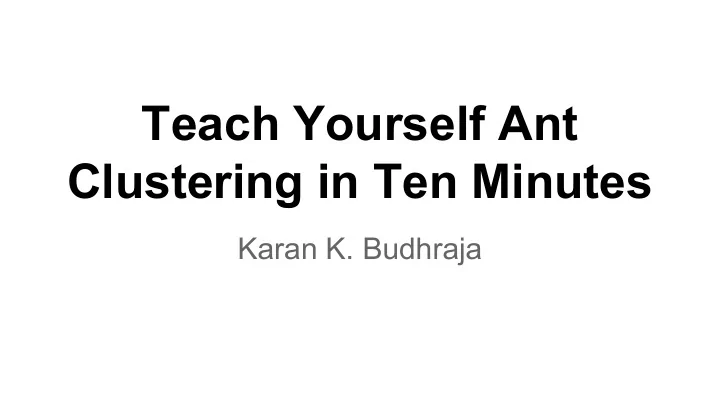

Teach Yourself Ant Clustering in Ten Minutes Karan K. Budhraja
What to Expect ● Basic model ● Brief associated content ● No mathematical equations!
Motivation ● Interest in nature inspired algorithms ○ applied to Machine Learning or Artificial Intelligence ○ explored in personal work ● Clustering ○ unsupervised learning ○ important in context of Information Retrieval
Definitions ● Clustering ○ grouping of objects based on similarity ● Swarm Intelligence ○ use many unintelligent agents to perform intelligent task ○ software agents ○ often nature inspired
Ants MVP! (for this presentation)
Related Work ● Ant Colony Optimization ○ ant foraging behavior ○ ants use chemical trails ○ shortest path emerges
Ant Clustering in Nature ● Cemetery formation ○ form piles of corpses ○ keep nests clean! ● Brood sorting ○ sort minion ants
Ant Clustering (Basic Model) 1. Scatter items randomly in 2D space 2. Ants begin to move 3. Ants pick up items with probability P pick 4. Ants drop items with probability P drop ● P pick increases in dissimilar item locality ● P drop increases in similar item locality
Ant Clustering (Standard Model) ● Basic Model + modifications ○ no communication between ants ■ distributed approach ○ short term memory ■ remember recent drop locations ■ use them while carrying item ■ move towards similar drops
Variations (brief) ● Sense environment complexity ○ complexity based on item similarity in locality ○ agents focus on high complexity areas ● Sense environment / cluster density ● Sense ant odor ● Hybrid with traditional methods ○ K-Means clustering ○ Fuzzy C-Means clustering
Applications ● General benefits ○ linear complexity with #features ○ #clusters / seed not specified ○ inherently parallel ● Anomaly detection ● Exploratory data analysis
Example ● Ant based clustering by Christian Nitschke ● Example image ○ just in case video doesn’t work :)
Future Work ● Comparison with traditional methods ● Exploration of real world applications ● Parameter tuning, sensitivity ● Combination with traditional methods ○ best of both worlds
Further Reading ● Plethora of references in document OR ● Ignore everything and read this ○ Jafar, OA Mohamed, and R. Sivakumar. "Ant-based clustering algorithms: A brief survey." International journal of computer theory and engineering 2.5 (2010): 1793-8201.
Recommend
More recommend